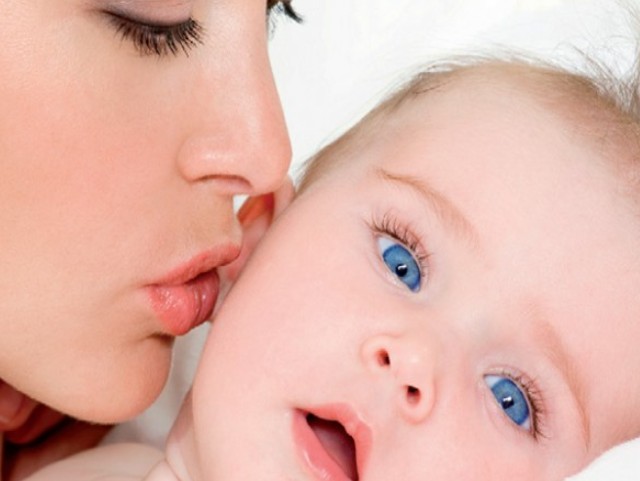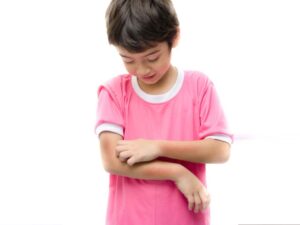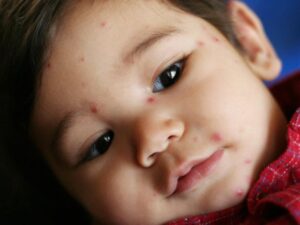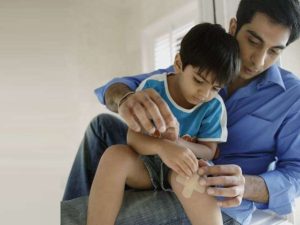There are some questions a young mother has always wanted answers to, but was too afraid to ask her busy doctors. There is a lot of confusion and misinformation when it comes to basic issues of skin care and grooming in infants and children. Your dermatologist is best equipped to address your concerns. Read on, for advice from the experts
1) What kind of toiletries and skin care products does my child need?
Soap-free and detergent-free liquid cleansers with a pH of 5.5 are ideal for infants and children, especially if they have dry skin or eczema. Cetaphil products are recommended by most dermatologists. You can add non-perfumed bath oils to the bath water. Seseme oil or Aveeno bath oil is a good choice. Bubble baths are meant to be treats and not a daily routine, as the chemicals and perfumes in bubble bath can irritate the genital area of young children. SLS free baby shampoos are mild, do not cause eye watering and are safe for daily use.
Moisturizers must be fragrance free, containing vegetable oil or lanolin. Sebamed and Aveeno products are very good. Use lotions in summer and creams in winter. Bland petroleum jelly or cocoa butter are free from toxins and preservatives and are best suited for kids with itchy and ultra-sensitive skin. Baby oils and paraben containing cold creams can make your child’s skin darker in the sun.
As a rule, dermatologists recommend “no sunscreen” for baby’s less than 6 months of age, and it is ‘preferably avoided’ in children under 2 years of age. If your baby is out in the sun, use a cap and umbrella. Full-sleeved clothing helps as long as it’s a comfortable fit, light-weight and breathable. For kids under the age of 2, try a calamine or zinc based sunscreen. After the age of 2, you can use sunscreens suitable for kids. Banana Boat, Vichy, Sebamed and La Roche Posay have sunscreens meant for the pediatric age group.
Talcum powder is useful to absorb moisture in the nappy area. They can prevent maceration in the skin fold of baby’s who have very fragile skin. Boric acid in talcum powders can cause vomiting, diarrhoea, lung inflammation and seizures in baby’s. Accidental inhalation is a potential hazard so I would not use a powder puff and I would only use talcum to powder a baby’s bottom or rub some around the neck fold and armpit using my fingers.
2) Does my little one really need oil massages?
Infant massage is an age old tradition which has passed down generations and has stood the test of time. It is a good way for mother and baby to bond with each other. And it also has multiple health benefits like strengthening the baby’s muscles and joints, improving digestion, colic relief, relief from teething pains, facilitating sleep, improving circulation and building your baby’s immunity to fight infections. Ask an elder in the family to teach you how to massage your infant, or learn it online from the innumerable videos available on the internet. Use mineral oil (like Johnson’s baby oil) if your baby has normal skin. Use olive oil or almond oil if your baby has dry skin. Do not apply oil inside the baby’s ears. Massage should be followed by a bath to wash off excess oil.
3) My baby was born with a lot of body hair. What can I do about it?
All baby’s are born with fine downy “lanugo” hair. It protects fetal skin from shrivelling up in the hot amniotic fluid. This hair falls off on it’s own in a year’s time, and in some cases, it may persist till the 2nd or 3rd year, especially if excessive body hair runs in your family. In some Asian countries, mothers use a wet mix of flour and milk with a pinch of turmeric and almond oil to rub onto the baby’s skin and pull out the hair. This is only a temporary fix and the hair will grow back every time the exfoliation is discontinued. It can also irritate your baby’s sensitive skin, so dermatologists do not endorse this practice.
4) Tell me something about good diaper habits.
Diaper rash occurs from using non-absorbent diapers, or leaving a diaper on for too long, or from not keeping the diaper area clean and dry. In some cases, the child might be allergic to the chemical fragrance of a disposable diaper or baby wet wipes, or the detergent used to wash a cloth diaper. It can get worse if your child suffers from diarrhoea, or if his eating habits have recently changed. The best defence is to change diapers at regular intervals, and kept the area clean and dry. If your child has already developed a rash, then use Decitin diaper rash cream along with plain zinc oxide paste from the pharmacy (for eg. RashFree cream). Use a slightly larger diaper, and give your baby’s bottom some “air time” for a few hours every day. A plastic sheet will protect your flooring and mattress. Your dermatologist may prescribe an anti-fungal cream for a few days to treat super-added yeast infections.
5) How should I take care of my baby’s teeth and gums?
Teach your child to develop and maintain healthy oral habits from an early age. For baby’s younger than 6 months of age, wrap a clean wet cloth around your index finger and use it to wipe your baby’s tongue and gums clean. Teething rings should be cleaned regularly and chilled before use. When the first tooth comes in, use a soft bristled tooth brush without tooth paste and continue massaging gums and teeth with a clean wet cloth. Make your child’s first dental appointment by his first birthday. Brown or white stains on the teeth indicate dental decay, and must be treated quickly or they may damage the permanent teeth as well, even before they appear. You can start using baby toothpaste after 18 months of age, in consultation with your local dentist on brands with or without fluoride. Do not let your child fall asleep with a bottle or pacifier. By age 3, your child should be completely weaned off the bottle, pacifier and/or thumb sucking. Brush their teeth twice a day, and ensure that they do not swallow the paste (you can do that by cleaning out their mouths with a clean wet cloth). By age 6 or 7, your child will be able to brush on his own.
6) My little girl is losing a lot of hair, what can I do?
The ‘100 hair a day’ rule applies to kids as well and in 9 out of 10 cases, these fears are largely exaggerated. However, temporary hair shedding can be noticed in children after a period of illness or psychological stress. Anemia, malnutrition and thyroid disorders can also cause hair fall in children. Sometimes the hair fall could be caused by fungal infections of the scalp or a medical condition known as ‘diffuse alopecia areata’. These conditions can only be diagnosed by trained dermatologists. Cancer and trichotillomania (compulsive hair pulling) are rare causes of hair fall in kids. The MOST common cause of hair thinning in young girls is generally a result of tight hair braids, tight clips, rubber hands and pony tails!
7) Which insect repellent cream should I use for my kids?
Insect repellent creams contain a pesticide called DEET, which is not safe for daily use in kids. Try an herbal alternative, or get an insect repellent bracelet for your kid. If you wish to make your own insect repellent lotion at home, use lemon juice, apple cider vinegar or witch hazel diluted 1:1 in boiled water, as a base for your homemade concoction. These ingredients also act as preservative, so your potion will last a couple of weeks at least. Add 15 drops of eucalyptus oil (for kids older than 3 years), lavender oil, citronella, lemongrass, peppermint oil and/or neem oil. Place this preparation into a spray bottle for easy and convenient use.
8) When can I get my daughter’s ears pierced?
The earlier you get it done, the wiser. Baby’s between 4-8 months of age are less likely to struggle and the ear piercing can be done smoothly and without accident. The skin of a young infant heals a lot faster as well. Wait for at least 4 months, so your child can get 2 tetanus shots before she gets her ears pierced. If you have not done it by then, you can always wait till your daughter is old enough to ask for it. Older girls are responsible enough to care for their own studs and keep their hands off it. Always mark the lobes first and ensure that you are completely satisfied with the position and symmetry of the markings. Gold, titanium and nickel-free stainless steel studs are the safest to use. Clean the pierced area with alcohol swabs and apply antibiotic cream for a week after the piercing. Leave on the initial stud for 2 months at least, as the freshly pierced skin tends to contract as it heals. Prefer studs to hoops as the stem is thicker, so the hole won’t close up or shrink. Consult a dermatologist if you notice swelling, redness, pain or pus discharge which persists for more than 2 days after a piercing.
9) My child gets prickly heat every summer.
Heat rash, or prickly heat is the appearance of small itchy red bumps on the folds of the skin, or on the back, when your child’s skin overheats in summers. Avoid dressing your child in layers during the summer. Use lotions instead of cream to moisturize your child’s skin in summer, and avoid moisturizer altogether until the rash subsides. Avoid using vaporizing cough rubs on the body; this can worsen the heat rash. A heat rash is a sign that your child’s body is getting too warm, so keep your child in cooler environs, and give plenty of fluids to avoid a heat stroke. Bathe your child in cool water, adding a spoonful of baking soda to your child’s bath tub. Keep nails short to avoid scratch marks and tears in the skin. A light dusting of corn starch to dry skin, immediately after the bath, is helpful. Use calamine lotion over the rash, to soothe the irritation.
10) My kid is embarrassed about her birthmark
In most cases, kids only become embarrassed about their physical imperfections when their parents obsess over it and make them feel self-conscious. Get a plastic surgeon’s opinion, but keep in mind that a vast majority of birthmarks are completely harmless. Birthmark removals are rarely doctor recommended, and are done solely for cosmetic purposes. Depending upon the type of birthmark, your doctor may offer you laser treatments or surgical removal. If these sound too drastic to you, try camouflage make-up to cover up birthmarks which are flat and level with the skin. These last for up to 16 hours and are water-resistant. Just a little touch-and-dab make up can make a world of difference to your child’s self-esteem.




